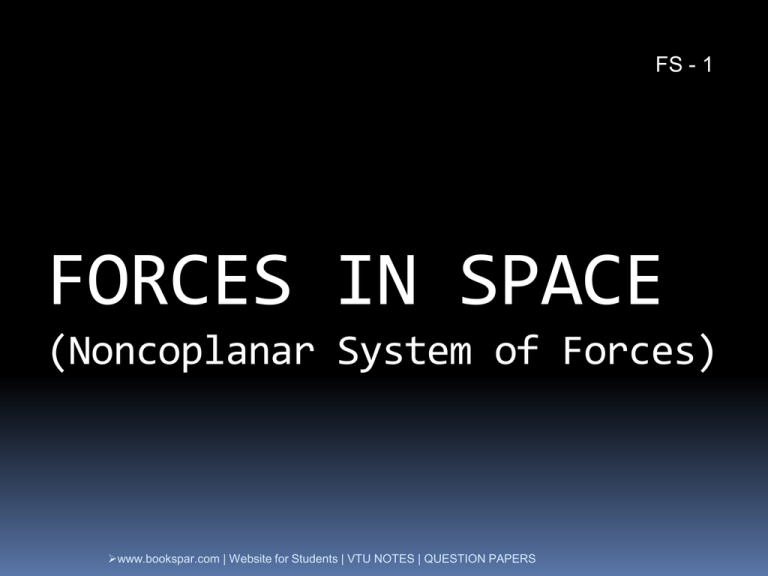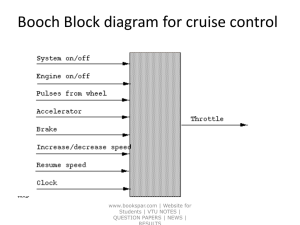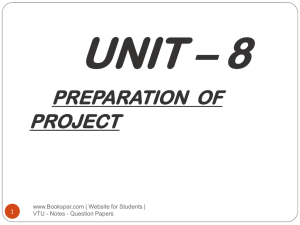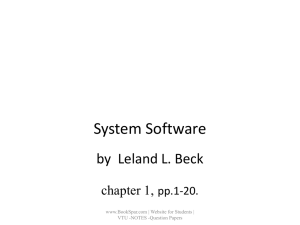Engg-Mechanics-Non-Coplanar-Force-system
advertisement

FS - 1 FORCES IN SPACE (Noncoplanar System of Forces) www.bookspar.com | Website for Students | VTU NOTES | QUESTION PAPERS Forces in space FS - 2 A Force in space: A Force is said to be in space if its line of action makes an angle α, β and γ with respect to rectangular co-ordinate axes X, Y and Z respectively as shown the Fig. 1. F Fig. 1. A Force in space www.bookspar.com | Website for Students | VTU NOTES | QUESTION PAPERS Forces in space FS - 3 Noncoplanar system of forces (Forces in Space) and Their Classifications System of forces which do not lie in a single plane is called noncoplanar system of forces(Forces in space ). A typical noncoplanar system of forces (forces in space) is shown in the Fig. 2. below Fig. 2 Forces in space (noncoplanar system of forces) www.bookspar.com | Website for Students | VTU NOTES | QUESTION PAPERS FS - 4 Forces in space Noncoplanar system of forces(Forces in space) can be broadly classified into three categories. They are 1. Concurrent noncoplanar system of forces 2. Nonconcurrent noncoplanar system of forces 3. Noncoplanar parallel system of forces www.bookspar.com | Website for Students | VTU NOTES | QUESTION PAPERS FS - 5 Forces in space 1. Concurrent noncoplanar system of forces: Forces which meet at a point with their lines of action do not lie in a plane are called “Concurrent noncoplanar system of forces”. A typical system of Concurrent noncoplanar system of forces is shown in the Fig.3. Fig. 3. Concurrent noncoplanar system of forces www.bookspar.com | Website for Students | VTU NOTES | QUESTION PAPERS FS - 6 Forces in space 2. Nonconcurrent noncoplanar system of forces: Forces which do not meet at a point and their lines of action do not lie in a plane, such forces are called “Nonconcurrent noncoplanar system of forces”. A typical system of nonconcurrent noncoplanar system of forces is shown in the Fig.4. Fig. 4. Nonconcurrent noncoplanar system of forces www.bookspar.com | Website for Students | VTU NOTES | QUESTION PAPERS Forces in space FS - 7 3. Noncoplanar parallel system of forces: If lines of action of all the forces in a system are parallel and they do not lie in a plane such a system is called Non-coplanar parallel system of forces. If all the forces are pointing in one direction then they are called Like parallel forces otherwise they are called unlike parallel forces as shown in the Fig.5. Fig. 5 Noncoplanar parallel system of forces www.bookspar.com | Website for Students | VTU NOTES | QUESTION PAPERS Forces in space FS - 8 Rectangular components of a force in space Fig. 6. Resolving a force in space into rectangular components www.bookspar.com | Website for Students | VTU NOTES | QUESTION PAPERS FS - 9 Forces in space Rectangular components of a force in space In the Fig.6(a) a force F is acting at the origin O of the system of rectangular coordinate axes X,Y,Z. Consider OBAC plane passing through the force F. This plane makes an angle with respect to XOY plane. Force F makes an angle θy with respect to Y-axis. Fig.6(a) www.bookspar.com | Website for Students | VTU NOTES | QUESTION PAPERS Forces in space FS - 10 Rectangular components of a force in space Fig.6(b) In the Fig.6(b), the force F is resolved in the vertical (Y- axis) and horizontal direction (X – axis) as Fy = F Cosy and Fh = F Siny respectively. www.bookspar.com | Website for Students | VTU NOTES | QUESTION PAPERS Forces in space FS - 11 Rectangular components of a force in space Fig.6(c) In the Fig 6(c) the horizontal component Fh is again resolved in the X and Z axes directions. These components are Fx = Fh cos = F siny cos Fz = Fh Sin = F siny sin www.bookspar.com | Website for Students | VTU NOTES | QUESTION PAPERS Forces in space FS - 12 Now applying Pythagorean theorem to the triangles OAB and OCD F2 = (OA)2 = OB2 + BA2 = Fy2 +Fh2 ----------------(1) Fh2 = OC2 = OD2 + DC2 = Fx2 +Fz2 ----------------(2) Substituting equation (2) into the equation (1), we get F2 = Fx2 +Fy2 + Fz2 F = Fx2 + Fy2 + Fz2 ----------------(3) www.bookspar.com | Website for Students | VTU NOTES | QUESTION PAPERS Forces in space FS - 13 The relationship existing between the force F and its three components Fx, Fy, Fz is more easily visualized if a box having Fx, Fy, Fz for edges is drawn as shown below. The force F is then represented by the original OA of this box. Fig. 7 Relationship between Force F and its components Fx, Fy and Fz www.bookspar.com | Website for Students | VTU NOTES | QUESTION PAPERS Forces in space FS - 14 From the above Figure (Fig. 7) Fx = F Cos x, Fy = F Cosy, Fz = F Cosz ------------(4) Where x, y, z are the angles formed by the force F with X, Y, Z axes respectively. Fx,Fy,Fz are the rectangular components of the force F in the directions of X, Y, Z axes respectively. Cos x = Fx/F; Cosy = Fy/F; Cosz = Fz/F Substituting equation (4) into the equation (3), we get F = Fx2 + Fy2 + Fz2 F = F2Cos2x + F2Cos2y + F2Cos2z F2 = F2 ( Cos2x + Cos2y + Cos2z ) 1 = Cos2x + Cos2y + Cos2z -------------(5) www.bookspar.com | Website for Students | VTU NOTES | QUESTION PAPERS Forces in space FS - 15 Force Defined by its magnitude and two points on its line of action From the adjacent Fig. 8. dx= d Cos x, dy = d Cosy, dz = d Cosz ----(6) d = dx2 + dy2 + dz2 ---(7) Dividing member by member the relations (4) and (6), we obtain Fx /dx = Fy/dy = Fz/dz = F/d ----------------------------(8) Fig 8 www.bookspar.com | Website for Students | VTU NOTES | QUESTION PAPERS FS - 16 Forces in space Resultant of concurrent forces in Space:Resolve all the forces into their rectangular components in X, Y and Z axes directions. Adding algebraically all the horizontal components in the x direction gives Rx = Fx, Similarly adding algebraically all the components in y and z directions yield the following relations Ry = Fy, Rz = Fz Thus magnitude of resultant R = Rx2 + Ry2 + Rz2 Angles x, y, z resultant forms with the axes of coordinates are obtained by Cos x Rx R ; Cos y Ry R ; Cos z Rz R Forces in space FS - 17 Problems: (1) A tower guy wire is anchored by means of a bolt at A is shown in the following Figure. The tension in the wire is 6000N. Determine (a) The components Fx, Fy, Fz of the forces acting on the bolt. (b) The angles x, y, z defining the direction of the force. www.bookspar.com | Website for Students | VTU NOTES | QUESTION PAPERS Forces in space FS - 18 Solution: (a) Here dx = 50m, dy = 200m, dz = -100m Total distance A to B d = dx2 + dy2 + dz2 = (50)2 + (200)2 + (-100)2 = 229.13 m Using the equation (8) Fx /dx = Fy/dy = Fz/dz = F/d Fx = dx . (F/d) = (50 x 6000)/ 229.13 = 1309.3 N Fy = dy . (F/d) = (200 x 6000)/ 229.13 = 5237.20 N Fz = dz . (F/d) = (-100 x 6000)/ 229.13 = -2618.6 N www.bookspar.com | Website for Students | VTU NOTES | QUESTION PAPERS Forces in space FS - 19 (b) Directions of the force: Cos x = dx /d , x = Cos–1 (50/229.13) = 77.4 y = Cos–1 (dy /d) = Cos–1 (200/229.13) = 29.2 z = Cos–1 (dz /d) = Cos–1 (-100/229.13) = 115.88 www.bookspar.com | Website for Students | VTU NOTES | QUESTION PAPERS Forces in space FS - 20 Problem(2) Determine (a) the x , y and z components of the 250 N force acting as shown below (b) the angles x, y, z that the force forms with the coordinate axes. www.bookspar.com | Website for Students | VTU NOTES | QUESTION PAPERS Forces in space Fh = 250 Cos60 = 125 N Fx = 125 Cos25 = 113.29 N FS - 21 Fy = 250 Sin60 = 216.5 N Fz = 125Sin25 = -52.83 N x = Cos–1 ( Fx /F) = Cos–1 (113.29/250) = 63 y = Cos–1 ( Fy /F) = Cos–1 (216.5/250) = 30 z = Cos–1 ( Fz /F) = Cos–1 (-52.83/250) = 102.11o Components of 250 N in the x, y, z axes directions are Fx = 113.29N Fy = 216.5 N Fz = -52.83N www.bookspar.com | Website for Students | VTU NOTES | QUESTION PAPERS Forces in space FS - 22 Problem 3. Find the resultant of the system of forces as shown below www.bookspar.com | Website for Students | VTU NOTES | QUESTION PAPERS Forces in space Solution Components of Force F1 = 3000 N: o Fy1 = 3000 x Cos40 = 2298.13 N o Fh1 = 3000 x Sin40 = 1928.36 N o Fx1 = 1928.36 x Cos30 =1670 N o Fz1 = 1928.36 x Sin30 = 964.18 N www.bookspar.com | Website for Students | VTU NOTES | QUESTION PAPERS FS - 23 Forces in space Components of Force F2 = 2000 N: Fy2 = 2000 x Cos20 = 1879.39 N Fh2 = 2000 x Sin20 = 684.04 N Fx2 = 684.04 x Sin35 = 392.35 N Fz2 = 684.04 x Cos35 = 560.33N www.bookspar.com | Website for Students | VTU NOTES | QUESTION PAPERS FS - 24 Forces in space FS - 25 Rx = Fx = Fx1 + Fx2 = 1670 – 392.35 = 1277.65 Ry = Fy = Fy1 + Fy2 = 2298.13 + 1879.39 = 4177.52 N Rz = Fz = Fz1 + Fz2 = 964.18 + 560.33 = 1524.51 N Resultant R = Rx2 + Ry2 +Rz2 = 1277.652 +4177.522 +1524.512 = 4626.9 N Its inclinations with respect to x, y and z axes are calculated as x = Cos–1 (1277.65 /4626.9) = 73 58' 13.1" y = Cos–1 (4177.52/4626.9) = 25 27' o –1 z = Cos (1526.51/4626.9) = 70 45’36” www.bookspar.com | Website for Students | VTU NOTES | QUESTION PAPERS Forces in space FS - 26 Problem 4. In the Fig shown below, the forces in the cables AB and AC are 100 kN and 150 kN respectively. At the joint ‘A’ loading is as shown in the Fig. Find the resultant of system of forces in space and its inclination with rectangular coordinates x,y and z axes. www.bookspar.com | Website for Students | VTU NOTES | QUESTION PAPERS Forces in space FS - 27 Solution: Force in the cable AB = 100 kN Force in the cable AC=150 kN For the cable AB dx = -20 m dy = 15m dz = 5m dAB = dx2 +dy2 + dz2 = (-20)2 +(15)2 + (5)2 = 650 = 25.5 m For the cable AC dx = -20 m dy = 25m dz = -10m 2 +(25) 2 + | (-10) 2 = 1125 = 33.54 m dAc |=Website (-20) www.bookspar.com for Students | VTU NOTES QUESTION PAPERS Forces in space For the cable AB (1) Fx1/dx1 = Fy1/dy1 = Fz1/dz1 = F/d Fx1/-20 = Fy1/15 = Fz1/5 = 100/25.5 Fx1 = -78.41 kN Fy1 = 58.82 kN Fz1 = 19.61 kN For the Cable AC (2) Fx2/-20 = Fy2/25 = Fz2/-10 = 150/33.54 Fx2 = - 89.45 kN Fy2 = 111.81 kN Fz kNfor Students | VTU NOTES | QUESTION PAPERS www.bookspar.com | Website 2 = - 44.72 FS - 28 Forces in space Component of force 60 kN Fx3 = 60 x Cos(70) = 20.52 kN Fy3 = 60 x Cos(30o) = 51.96 kN Fz3 = 60 x Cos(11123)= - 21.88 kN Component of the force 50KN Fx4 = 50 kN Fy4 = 0 Fz4 = 0 www.bookspar.com | Website for Students | VTU NOTES | QUESTION PAPERS FS - 29 Forces in space FS - 30 Algebraic summation of Rectangular Components in X, Y and Z axes directions yield: Rx = Fx = Fx1 + Fx2 + Fx3 + Fx4 = -78.43 - 89.45 + 20.52 + 50 = -97.36 kN Ry = Fy = Fy1 + Fy2 + Fy3 + Fy4 = 58.82 + 111.81 + 51.96 + 0 = 222.59 kN Rz = Fz = Fz1 + Fz2 + Fz3 + Fz4 = 19.61 – 44.72 – 21.88 + 0 = -46.99 kN Resultant R = Rx2 + Ry2 + Rz2 = (-97.36)2 + (222.59)2 + (-46.99)2 = |247.45 kN | VTU NOTES | QUESTION PAPERS www.bookspar.com Website for Students Forces in space FS - 31 Inclinations of the resultant with X,Y and Z axes: x = Cos-1(Rx / R) = Cos-1 (-97.36/247.45) = 113 10’ y = Cos-1(Ry / R) = Cos-1 (222.59/247.45) = 25 54’ z = Cos-1(Rz / R) = Cos-1 (-46.99/247.45) = 100 56’ 47” Check: Cos2x + Cos2y + Cos2z = 1 Cos2(11310’) + Cos2(2554’) + Cos2(10056) = 1 1 = 1 Hence OK www.bookspar.com | Website for Students | VTU NOTES | QUESTION PAPERS Forces in space FS - 32 Problem 5. a) Forces F1, F2, and F3 pass through the origin and points whose coordinates are given. Determine the resultant of the system of forces. F1 = 20 kN, (3,-2,1) F2 = 35 kN, (-2,4,0) F3= 25 kN, (1,2,-3) www.bookspar.com | Website for Students | VTU NOTES | QUESTION PAPERS Forces in space Solution: www.bookspar.com | Website for Students | VTU NOTES | QUESTION PAPERS FS - 33 Forces in space Force F1 = 20 kN d = 32 + (-2)2 + 12 = 14 = 3.74 Cos x1 = dx / d = 3/3.74 = 0.802 Cos y1 = -2/3.74 = -0.535; Cos z1 = 1/3.74 = 0.267 Force F2 = 35 kN d = (-2)2 + 42 +0 = 20 = 4.47 Cos x2 = -2/4.47 = -0.45 Cos y2 = 4/4.47 = 0.9; Cos z2 = 0 Force F3 = 25 kN d = (1)2 + 22 +(-3)2 = 14 = 3.74 Cos x3 = 1/3.74 = 0.267 Cos y3 = 2/3.74 = 0.535; Cos z3 = -3/3.74 = -0.802 www.bookspar.com | Website for Students | VTU NOTES | QUESTION PAPERS FS - 34 Forces in space FS - 35 Summation of the rectangular components in X, Y and Z axes directions yield: Rx = Fx = 20 x 0.802 + 35 x (-0.45) +25 x 0.267 = 6.965 kN Ry = Fy = 20 x (-0.535) + 35 x 0.9 + 25 x 0.535 = 34.175 kN Rz = Fz = 20 x 0.267 + 35 x 0 + 25 x (-0.802) = -14.71 kN Resultant R = Rx2 + Ry2 + Rz2 = 6.9652 + 34.1752 + (-14.71)2 = 37.85 kN Inclination of the resultant R with respect to X, Y and Z axes are calculated as x = Cos–1(Rx / R) = Cos-1(6.965/37.85 ) = 79.4 y = Cos–1(Ry /R) = Cos-1(34.175/37.85) = 25.46 -1(-14.71/37.85) = 112.87 z www.bookspar.com = Cos–1(Rz |/R) = Cos Website for Students | VTU NOTES | QUESTION PAPERS Forces in space FS - 36 Equilibrium of Concurrent non-coplanar system of forces: When a rigid body subjected to concurrent noncoplanar system of forces F1, F2…. ..FN as shown in the Fig. given below, is in equilibrium, then algebraic summation of all the components of the forces in three mutually perpendicular directions must be equal to zero. i.e. Fx = 0 Fy = 0 Fz = 0 (1) Above equations represent the static conditions of equilibrium for concurrent noncoplanar system of forces Fig. A rigid body subjected to concurrent www.bookspar.com | Website for Students | VTU NOTES | QUESTION PAPERS noncoplanar system of forces Forces in space FS - 37 Problem (1) Find the forces in the rods AB , AC and AO subjected to loading as shown below www.bookspar.com | Website for Students | VTU NOTES | QUESTION PAPERS Forces in space Solution: For the cable AB: dx1 = 0 - 4 = - 4 dy1= 8 - 0 = 8 dz1 = 15 – 0 =15 d1 = (-4)2 +(8)2 +(15)2 = 17.46 m Fx1/-4 = Fy1/8 = Fz1/15 = FAB/17.46 Fx1 = -0.23FAB, Fy1 = 0.46FAB, Fz1 = 0.86FAB www.bookspar.com | Website for Students | VTU NOTES | QUESTION PAPERS FS - 38 Forces in space For the Cable AC: dx2 = 0 - 4 = -4m dy2 = 8 - 0 = 8m dz2 = -20 – 0 = -20m d2 = (-4)2 +(8)2 +(-20)2 = 480 = 21.91m Fx2/-4 = Fy2/8 = Fz2/-20 = FAC/21.91 Fx2 = -0.18FAC, Fy2 = 0.365FAc, Fz2 = -0.91FAc For the Force 120 N: Fx3 = 120 N, Fy3 = 0, Fz3 = 0 For the force Fx4 = 300 N: Fx4 = 0, Fy4 = -300N, Fz4 = 0 www.bookspar.com | Website for Students | VTU NOTES | QUESTION PAPERS FS - 39 Forces in space Conditions of Equilibrium Fx = 0, Fy = 0, Fz = 0 Considering Fx = 0 Fx1 + Fx2 + Fx3 + Fx4 + Fx5= 0 -FAD-0.23F – 0.18FAC + 120 + 0 = 0 FAD + 0.23FAB + 0.183FAC = 120 ----------------------(1) Fy = 0 0.46FAB + 0.365FAC + 0 +0 – 300 = 0 0.46FAB + 0.365FAC = 300 ------------------------------(2) Fz = 0 0.86 FAB – 0.91 FAC + 0 = 0 -----------------------(3) www.bookspar.com | Website for Students | VTU NOTES | QUESTION PAPERS FS - 40 Forces in space FS - 41 Solving Equations (1), (2) and (3), we get, FAB = 372.675 N; FAC = 352.25 N ; FAO = - 30.18 N Force in the rod AB , FAB = 372.675 N (Tensile) Force in the rod AC, FAC = 352.25 N (Tensile) Force in the rod AO, FAO = 30.18 N (Compressive) www.bookspar.com | Website for Students | VTU NOTES | QUESTION PAPERS Forces in space FS - 42 2) Three cables are connected at D and support, the 400 kN load as shown in the Fig given below. Determine the tensions in each cable www.bookspar.com | Website for Students | VTU NOTES | QUESTION PAPERS Forces in space FS - 43 Let FDA, FDB and FDC are the forces in the cables AD, BD, and CD respectively. For Cable DA: dx1 = (0 – 3) = -3m dy1 = (6 - 4) =2 m dz1 = (6 – 0 = 6 m dAD = dx2 + dy2 + dz2 dAD = (-3)2 + (2)2 + (6)2 = 9 + 4 + 36 = 7 m Fx1/dx1 = Fy1/dy1 = Fz1/dz1 = FDA/dDA Fx1/(-3) = Fy1/2 = Fz1/6 = FDA/7 Fx1 = -0.43FDA, Fy1 =0.286FDA, Fz1 = 0.857FDA www.bookspar.com | Website for Students | VTU NOTES | QUESTION PAPERS Forces in space For Cable DB: dx2= (0 – 3) = -3m dy2 = (6 - 4) =2 m dz2 = (-6 – 0 = -6 m dBD = d2 = (-3)2 + (2)2 + (-6)2 = 49 = 7 m Fx2/dx2 = Fy2/dy2 = Fz2/dz2 = FDB/dDB Fx2/(-3) = Fy2/2 = Fz2/-6 = FDB/7 Fx2 = -0.43FDB, Fy2 =0.286FDB, Fz2 = -0.857FDB www.bookspar.com | Website for Students | VTU NOTES | QUESTION PAPERS FS - 44 Forces in space For Cable DC: dx3 (0 – 3) = -3m dy3= (0- 4) = -4m dz3= (0 0 = 0m dDC= d3= (-3)2 + (-4) + (0)2 = 9 + 16 = 5m Fx3/dx3 = Fy3/dy3 = Fz3/dz3 = FDC/d DC Fx3/(-3) = Fy3/-4 = Fz3/0 = FDC/5 Fx3 = -0.6FDC, Fy3 =-0.8FDC, Fz3 = 0 www.bookspar.com | Website for Students | VTU NOTES | QUESTION PAPERS FS - 45 Forces in space For the force 400KN dx4 = 12m dy4= -4m dz4= 3m d4= d400 = (12)2 + (4) + (3)2 = 144 +16 + 9 = 69 = 13m Fx4/dx4 = Fy4/dy4 = Fz4/dz4 = F400/d4 Fx4/(12) = Fy4/-4 = Fz4/3 = 400/13 Fx4 = 369.23 kN, Fy4 = -123.08 kN, Fz4 = +92.31 kN www.bookspar.com | Website for Students | VTU NOTES | QUESTION PAPERS FS - 46 Forces in space FS - 47 For Equilibrium, the algebraic summation of resolved component in a particular direction is equal to zero. i.e. Fx = 0 -------------(1) Fy = 0 ------------- (2) Fz = 0 --------------(3) (1) Fx = Fx1 + Fx2 + Fx3 + Fx4 = 0 + 0.43FDA + 0.43FDB + 0.6FDC = 369.23 ---------(1) + 0.286FDA + 0.286FDB – 0.8FDC = 123.08 ------(2) + 0.857FDA - 0.857FDB + 0 = 92.31 ------------(3) www.bookspar.com | Website for Students | VTU NOTES | QUESTION PAPERS Forces in space Solving equations (1), (2) and (3), we get FDB = 304.1kN FDA = 411.8 kN FDC = 102 kN www.bookspar.com | Website for Students | VTU NOTES | QUESTION PAPERS FS - 48 Forces in space FS - 49 Practice Questions 1. A tower guy wire is anchored by means of a bolt at A as shown below. The tension in the wire is 2500 N. Determine (a) the components Fx, Fy and Fz of the force acting on the bolt, (b) the angles θx, θy, θz defining the direction of the force (Ans: Fx= -1060 N , Fy = 2120 N, Fz= + 795 N Θx = 115.1 o ; Θy= 32.0 o ; Θz= 71.5 o ) www.bookspar.com | Website for Students | VTU NOTES | QUESTION PAPERS Forces in space FS - 50 Practice 2. Determine Questions (a) x, y and z the components of the force 500 N in the below Figure. (b) the angles θx, θy, θz that the force forms with the coordinate axes (Ans: Fx= + 278 N , Fy = + 383 N, Fz= + 160.7 N Θx = 56.2 o ; Θy= 40.0 o ; Θz= 71.3 o ) www.bookspar.com | Website for Students | VTU NOTES | QUESTION PAPERS Forces in space FS - 51 3. In order to move a wrecked truck, two cables are attached at A and Practice Questions pulled by winches B and C as shown. Knowing that the tension in the cable AB is 10 kN, determine the components of the force exerted by the cable AB on the truck (Ans: Fx= -6.30 kN , Fy = 6.06 kN, Fz= + 4.85 kN) www.bookspar.com | Website for Students | VTU NOTES | QUESTION PAPERS Forces in space FS - 52 4. A 200 kg cylinder is hung by means of two cables AB and AC, which are Practice Questions attached to the top of a vertical wall. A horizontal force P perpendicular to the wall holds the cylinder in the position shown. Determine the magnitude of the force P and the tension in each cable (Ans: P = 235 N , TAB = 1401 N, TAC= + 1236 N ) www.bookspar.com | Website for Students | VTU NOTES | QUESTION PAPERS Forces in space FS - 53 5. Three cablesQuestions are connected at A, where the forces P and Q are applied as Practice shown. Determine the tension in each cable when P = 0 and Q = 7.28 kN (Ans: TAB= 2.88 kN , TAC = 5.76 kN, TAD= 3.6 kN) www.bookspar.com | Website for Students | VTU NOTES | QUESTION PAPERS FS - 54 Forces in space Practice Questions 6. A container of weight w = 400 N is supported by cables AB and AC which are tied to ring A. Knowing that Q = 0, determine (a) the magnitude of the force P which must be applied to the ring to maintain the container in the position shown in figure below, (b) the corresponding the values of the tension in cables AB and AC (Ans: P = 138 N , TAB = 270N, TAC = 196N ) www.bookspar.com | Website for Students | VTU NOTES | QUESTION PAPERS FS - 55 Forces in space Practice Questions 7. A container supported by three cables as shown below. Determine the weight of the container, knowing that the tension in the cable AB is 4 kN Ans: 9.32 kN www.bookspar.com | Website for Students | VTU NOTES | QUESTION PAPERS FS - 56 Forces in space Practice Questions 8. Determine the resultant of the two forces shown below. (Ans: R = 498 N , Θx = 68.9 o ; Θy= 26.3 o ; Θz= 75.1 o ) www.bookspar.com | Website for Students | VTU NOTES | QUESTION PAPERS FS - 57 Forces in space Practice Questions 9. A container of weight W = 1165 N is supported by three cables as shown below. Determine the tension in each cable. Ans: TAB = 500 N TAC = 459 N TAD = 516 N www.bookspar.com | Website for Students | VTU NOTES | QUESTION PAPERS www.bookspar.com | Website for Students | VTU NOTES | QUESTION PAPERS







